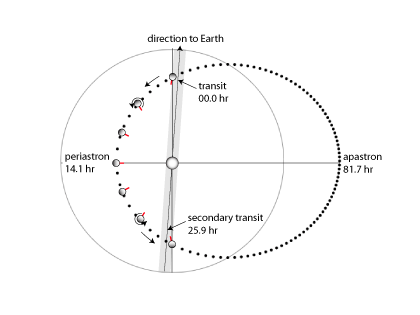
Image Source.
Jonathan Langton is at the AAS meeting in Hawaii, and on Wednesday, he’s going to be presenting the results from his latest simulations. Let’s just say that the animations show some amazing weather patterns on the eccentric planets that receive strongly variable stellar heating. If you’re in Honolulu, then by all means make sure you catch his talk. [It’s during the Wed. 4:15-6:00 PM Extrasolar Planets Session in Room 319. Here’s a link to his abstract.]
A ten-minute talk is barely enough time to hit the highlights of the simulations; fortunately, the full story will be available shortly in a paper that we’re readying for submission.
HAT-P-2b will almost certainly be one of the planets that makes the cut. This world is vying with HD 80606b as the most interesting potential candidate for future observations with the Spitzer Space Telescope. Despite having a relatively short 5.63-day orbital period, the orbit is quite eccentric: e=0.50. Periastron occurs almost exactly midway between the primary and secondary transits, which gives the system an absolutely ideal geometry for Spitzer.

Click here for a high-resolution .eps version.
If you can’t make it to the talk, then make sure to check back here at oklo.org in a day or so. I’ll be posting the latest pictures and animations from the simulations, and we’ll have a detailed look HAT-P-2b’s remarkable predicted light curve.

Also at AAS, they’re announcing XO-3b: another massive (12 Jupiters!) transiting hot Jupiter/Brown Dwarf with an eccentric (~0.2) orbit… around a low-metallicity star! This appears to be Hat-P-2b’s cousin around a 10th magnitude star.
Hi,
any news about the main star XO-3 ? The abstract just states that it is a 10th mag. F dwarf. Does anyone know the GSC or HIP number for this one ? Also, what is the amplitude of the transits ?
Cheers,
Luis
Jonathan Langton was at the X0-3 talk, and he gave me a summary on the phone this afternoon. It sounded to him like they are keeping the identity of the star under wraps until the preprint comes out. He also said it sounded like the radius of the planet is 1.9 Jupiter radii, which would imply a colossal interior source of energy. It’ll definitely be interesting to get the firm details from the preprint.